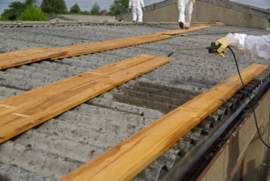
Illinois Asbestos Laws

Must Read
How Does the Government Legally Define Asbestos? The United States Environmental Protection Agency formally defines asbestos as a mineral fiber, often found in construction materials—due to its fire-retardant and insulating properties—that contains carcinogenic after effects if inhaled. Because of the asbestos’s fiber strength, the mineral was commonly used to fortify a number of manufactured goods, including buildings materials, such as ceiling tiles, floor tiles, roofing shingles, paper products and cement products, as well as friction materials, such as automobile brakes, transmission parts and clutches. When asbestos is damaged by repair or disturbed in any way, such as through renovation or demolition projects, microscopic particles become airborne. These particles, which are carcinogenic, become susceptible to inhalation. When perpetually inhaled, the fibers impose drastic long-term health problems. Prolonged exposure to asbestos significantly increases your risk of developing lung cancer or a slew of asbestos-related diseases. These risks are augmented by smoking and the level of exposure—obviously the longer one is exposed to asbestos the more likely they are to contract the cancer. Common asbestos-disease symptoms take several years to become tangible. Therefore, if you previously worked with asbestos fibers in the past it is critical that you undergo diagnostic or imaging tests in hopes of detecting the cancer during an early stage. Early detection for mesothelioma or other asbestos-based cancers is the only means to effectively cure the majority of asbestos-related cancers. Exposure to airborne asbestos fibers greatly increases the probability of developing mesothelioma and other lung cancers because the fibers stick to the organ’s lining and eat away at its protective tissues. Prolonged exposure to the deadly fibers increases the amount of carcinogens in the lungs. These fibers perpetuate the developments of serious diseases, cancer, asbestosis and mesothelioma. Three of the most intrusive health effects associated with asbestos exposure include the following: Lung Cancer: The largest number of asbestos-related deaths are caused by lung cancer. Individuals, who work manufacture, mine or mill asbestos, face a significant risk of developing lung cancer. Common symptoms associated with lung cancer include: painful breathing, difficulty swallowing and a persistent cough. Other symptoms include: anemia, shortness of breath and hoarseness. Malignant Mesothelioma: This asbestos-related disease is a rare form of cancer, typically found in the lining of the lungs, chest, the sac surrounding the heart or the abdomen. Malignant mesothelioma is directly linked to exposure to asbestos fibers. This cancer, due its slow-developing symptoms and innocuous cell structure does not become noticeable until 30-50 years following the patient’s first exposure to asbestos. Treatment options for malignant mesothelioma are dependent on diagnosis; the majority of treatment options, because of delayed diagnosis, are palliative in nature. If, by chance, the disease is detected in its earliest stages, curable surgeries may be administered to extract the cancerous cells from the body. Because early detection is highly unlikely, palliative treatment methods, such as radiation, chemotherapy and/or minor surgery are typically applied to mesothelioma patients. Asbestosis: This asbestos-related disease is a long-term non-cancerous condition that is serious in nature. Asbestosis develops from the persistent inhalation of asbestos fibers. These fibers eat away at the lining, forming a mass build-up of scar tissue. Scarring makes it difficult for oxygen to pass through to the blood. Common symptoms attached to an asbestosis diagnosis include: shortness of breath, chest pains and a crackling sound in the lungs while inhaling. Currently, there is no effective treatment for this asbestosis. Common Asbestos Laws in Illinois: Illinois asbestos laws are implemented to regulate the environmental and structural exposure of the deadly filament. Illinois asbestos laws are put in place to protect the state’s inhabitants and their environment. These laws aim to promote safety through the administration of proper executions of construction, demolition, renovation on commercial properties, garages, homes, warehouses etc. The state of Illinois regulates the majority of asbestos laws through the Illinois Asbestos Unit. This agency operates through regulations and strict rules to protect individuals from being overly-exposed to asbestos fibers. Similar to many asbestos regulations and laws, the Illinois Asbestos Unit strictly enforces the United States Federal Government’s National Emission Standards for Hazardous Air Pollutants. Asbestos Abatement Procedure in Illinois: In Illinois, Asbestos was a commonly used building material because of its aversion to heat and chemicals, as well as its inability to conduct electricity. Presently, however, asbestos fibers are regarded as a hazardous indoor air pollutant with links to the following respiratory diseases: mesothelioma cancer, lung cancer and asbestosis. The carcinogenic fiber was used in a variety of products that were once installed in commercial buildings and Illinois’ schools. During the mid-1980’s, Illinois legislation, along with several regulations instituted by the United States federal government, required that local schools be inspected for asbestos fibers. Following inspection, these areas were then the subject of management plans for the removal of the dangerous fibers. The Illinois Department’s Division of Environmental Health reviews these plans for all elementary and secondary educational facilities in the state—this agency is also responsible that said entities comply with state and federal laws concerning asbestos. Enacted legislation now regulates individuals who perform asbestos-related activities in public and commercial buildings and requires that these activities be carried-out in a safe manner. Individuals who manage or remove asbestos in elementary and secondary schools are required to be licensed and properly trained. Approximately 10,000 individuals are licensed per year to handle asbestos in the state of Illinois. The Division of Environmental Health establishes distinct licensing criteria for a variety of asbestos management disciplines. Each asbestos license expires on May 15th of each year; a workers’ Illinois asbestos license expires on the 1st of February each year. Asbestos Professional Requirements in the State of Illinois: All asbestos workers in the state of Illinois who work abatement projects in commercial, public or educational institutions must be properly licensed and trained to legally engage in their work. In turn, Contractors are responsible for partaking in asbestos abatement projects in the state. Every Illinois asbestos contractor who conducts asbestos abatement projects is required to have insurance and a state-issued abatement license. In the state of Illinois, all supervisors serve as the Contractor’s designees for asbestos abatement projects. These asbestos professionals are responsible for ensuring that work is conducted in adherence to state and federal regulations. An Illinois project manager refers to the building owner’s or school district’s overseer or representative for asbestos-related projects. These individuals, in the state Illinois, are responsible for ensuring that the supervisors and workers are complying with the contract’s specifications and all state and federal regulations that apply. A project manager is not required to oversee an asbestos abatement project in public or commercial buildings, but if a property owner opts to have an individual oversee the projects, then the Department will require that said individual be a licensed asbestos professional. A licensed Illinois inspector is an individual required to identify any asbestos-containing materials in a targeted area. Licensed inspectors in the state of Illinois identify asbestos filaments by sampling suspected asbestos-containing materials through the use of various cultures and high-tech equipment. A management planner, in the state of Illinois, is required to develop a management plan based on the information given by the Inspector. Each educational facility in the state of Illinois is required to develop—and actively maintain—an asbestos management plan, describing the management of the facility’s asbestos-containing building materials. All public and commercial buildings in the state are not required to develop a management plan for asbestos fibers; however, it is strongly recommended that they do so. If an asbestos related disease is contracted by an area that does not develop a management plan, said area will be deemed liable for their inability to identify and subsequently limit asbestos exposure.


















